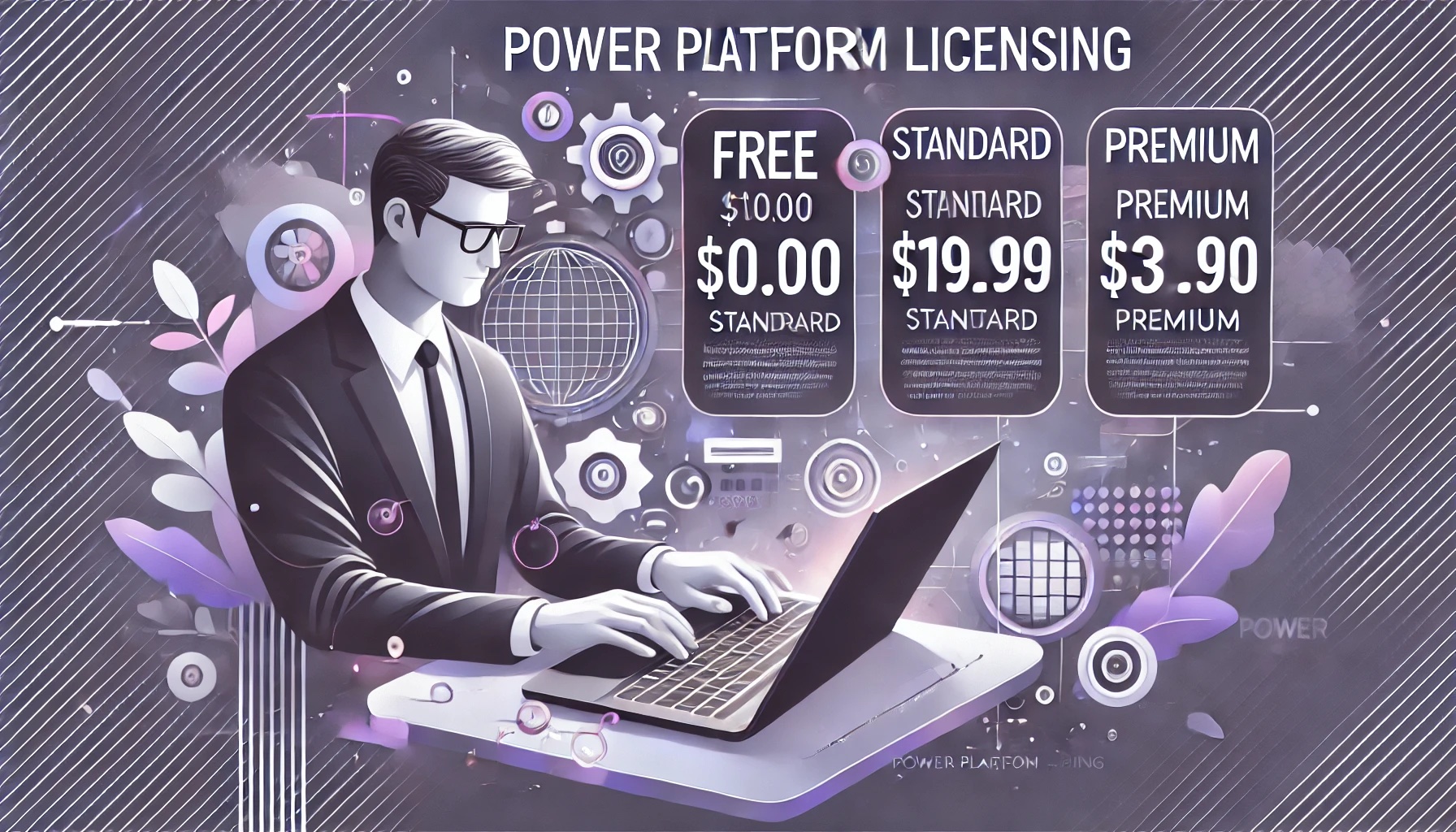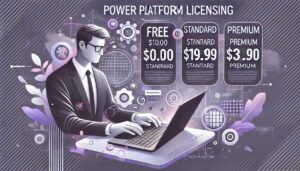In the rapidly evolving business landscape, companies are constantly on the lookout for innovative strategies to boost efficiency, minimize operational costs, and accelerate growth. A standout solution in this quest is the Microsoft Power Platform. This powerful suite includes a variety of applications, connectors, and a robust data platform known as Dataverse. It’s designed to foster the development of custom apps, streamline workflow automation, and enhance data analysis. Despite its potential, many organizations struggle with the platform’s complex licensing structure and the overall cost and value of its implementation.
In this article, we will look into the economic factors associated with the adoption of Microsoft Power Platform solutions. Here is what we will look at in this article:
- Licensing Structure – We’ll review the array of licensing options available, from the included Microsoft 365 licenses to the more adaptable pay-as-you-go plans. This exploration helps organizations understand which licensing model aligns best with their operational needs and budget constraints.
- Costs and Benefits – Our research delves into both the apparent and hidden costs associated with these licensing options, while also highlighting the tangible and intangible benefits. This comprehensive analysis aims to provide a clearer picture of the overall economic impact of adopting Power Platform solutions.
- Return on Investment (ROI) – Through case studies and empirical data, we demonstrate how strategic investments in Power Platform can lead to significant ROI. This section aims to offer actionable insights that prove the cost-effectiveness of various licensing strategies, enhancing business processes and driving innovation.
Ultimately, this blog is crafted to empower decision-makers with the essential knowledge and tools necessary to assess the real value of Power Platform solutions, ensuring that their investments are both data-driven and closely aligned with their strategic objectives.
Licensing Structure
Let’s begin by taking a deeper look at the licensing models in the Power Platform. For our analysis we will focus on PowerApps and Power Automate. For the other Power Platform tools, please visit the official licensing guide
Power Apps Licensing
Power Apps offers several licensing options tailored to different business needs. The Power Apps Premium license is ideal for businesses that require users to run an unlimited number of applications. This license is priced at $20 per user per month, with discounts available for larger license purchases, such as $12 per user per month for 2,000 or more licenses. This premium option includes the ability to run unlimited custom applications and access unlimited Power Pages websites, making it suitable for organizations with extensive app usage requirements.
For businesses needing a more limited scope, the Power Apps per App license allows individual users to run one specific application or access one website. This option is priced at $5 per user per month and is best for users who only need access to a few apps or websites. Additionally, the Power Apps per App Pay-As-You-Go meter charges based on the actual number of unique users accessing an app, costing $10 per active user per app per month. This model is advantageous for scenarios with unpredictable or highly variable usage patterns, offering flexibility and cost control.
Both the Power Apps Premium and per app licenses include integration with standard and premium connectors for data integration, full Dataverse access with accrued database and file capacities, and AI Builder credits for enhancing automation and AI functionalities.
Power Automate Licensing
Power Automate also provides various licensing options to cater to different automation needs. The Power Automate Premium license, priced at $15 per user per month, allows users to automate modern applications through API-based digital process automation (cloud flows) and legacy applications via UI-based robotic process automation (RPA) in attended mode. This license includes unlimited cloud and attended desktop flows, AI Builder service credits, and process mining data storage.
For businesses focusing on critical business processes, the Power Automate Process license is available at $150 per bot per month. This license covers a single automation bot for unattended automation or UI-based digital process automation, including process mining and access to AI Builder service credits. Additionally, the Power Automate per Flow license is priced at $100 per flow per month, with a minimum purchase requirement of five licenses. This model allows organizations to implement critical business processes without the need to license individual users.
The Power Automate Process Mining add-on license, costing $5,000 per 100 GB of data stored per month, enables customers to identify optimization opportunities and improve existing processes. This capacity-based license supports rapid return on investment (ROI) through critical process enhancements.
Overall, Power Automate licenses offer extensive capabilities for automating cloud and desktop processes, integrating with standard and premium connectors, and leveraging advanced AI Builder functionalities.
Costs and Benefits of the Licensing Models
So which licences are the most suitable for your needs? Here is a brief analysis:
Power Apps Licensing
- Per App Model
The ‘Per App’ model is praised for its cost-efficiency, particularly for organizations needing a limited number of applications. This model allows individual users to run up to two custom apps and access one custom portal, making it suitable for specific use cases without incurring the costs of a full per-user license.
One notable challenge with the ‘Per App’ model is the requirement for separate licenses for each environment when using the same app. This can increase costs and administrative overhead, particularly for organizations with multiple development and production environments.
- Per User Model
The ‘Per User’ licensing model offers broader access, enabling users to run multiple custom applications. This model is beneficial for organizations with comprehensive app requirements and frequent usage, providing Dataverse database, file capacity, and daily API request limits.
While the ‘Per User’ model is more flexible, its broader access can lead to higher costs compared to the ‘Per App’ model, especially for organizations with limited app usage needs. Users also report complexity in managing multiple applications under this license.
- Pay-As-You-Go Model
The ‘Pay-As-You-Go’ model provides financial flexibility by allowing businesses to pay based on actual app usage. This model is ideal for organizations with seasonal or fluctuating app usage, ensuring they only pay for what they use without committing to a fixed monthly fee.
Managing the cost associated with fluctuating usage can be challenging, as unexpected spikes in usage can lead to higher-than-anticipated costs. This model also requires careful monitoring to avoid cost overruns.
Power Automate Licensing
- Power Automate Premium
The ‘Power Automate Premium’ license supports extensive automation capabilities, including both modern applications and legacy systems. It enables unlimited cloud and attended desktop flows, making it suitable for diverse automation needs.
Implementing advanced automation features can pose a learning curve, necessitating additional training and support for effective use. Additionally, managing costs for extensive automation processes requires careful planning.
- Power Automate Process
The ‘Power Automate Process’ license is valuable for automating critical business processes without individually licensing each user. This model is beneficial for departmental scenarios where automation can significantly enhance efficiency.
While offering process optimization, the cost associated with capacity-based pricing can be high, particularly for organizations with extensive data and automation needs. Managing these costs effectively requires detailed analysis and planning.
Return on Investment (ROI) of Power Platform
licensing models provide tailored solutions for various business needs, enhancing operational efficiency, and delivering high ROI. Selecting the appropriate model depends on the specific requirements and usage patterns of the organization, ensuring cost-effectiveness and optimal resource utilization. Here is a brief analysis on how to maximize your ROI investing in Power Platform.
Power Apps Licensing
Investing in the Power Apps premium license offers several substantial benefits. One of the primary advantages is enhanced data management through full access to Dataverse. This allows businesses to centralize their data storage and management, ensuring consistency and reliability across all applications. The premium license also supports advanced app development by enabling the creation of both canvas and model-driven apps. This flexibility allows organizations to design sophisticated, tailored applications to meet specific business needs. Additionally, premium connectors facilitate seamless integration with a wide array of third-party and advanced Microsoft services, ensuring comprehensive data and process integration. Moreover, AI Builder capabilities included in the premium license provide credits for incorporating AI-driven features such as form processing and object detection, significantly enhancing app functionalities.
These capabilities lead to improved data accuracy and decision-making, increased productivity, and enhanced customer experiences through integrated services and AI functionalities, ultimately delivering a high return on investment.
Licensing Models:
Per App Model
The ‘Per App’ model is ideal for small to mid-sized businesses needing a limited number of applications, typically with 50-200 employees. This model costs $5 per user per app per month. For example, if a company has 50 users requiring two apps, the monthly cost would be $500, amounting to $6,000 annually. This model provides additional returns by allowing businesses to leverage enhanced data management and AI-driven features for specific app use cases.
Per User Model
The ‘Per User’ model suits mid to large-sized organizations with extensive app usage, typically those with 100 or more employees. It costs $20 per user per month. For instance, a company with 100 users would incur a cost of $2,000 per month or $24,000 annually. This model offers additional returns by granting access to all Power Apps, advanced data capacity, and premium connectors, supporting extensive and frequent app usage.
Pay-As-You-Go Model
The ‘Pay-As-You-Go’ model is suitable for businesses with highly variable or seasonal app usage. It costs $10 per active user per app per month. For example, if a company has 200 users during peak months (4 months) and 20 users off-season (8 months), the annual cost would be $9,600. This model provides flexibility to scale usage up or down without over-committing resources, ensuring cost efficiency.
Power Automate Licensing
Investing in the Power Automate premium license brings comprehensive automation benefits. The license supports unlimited cloud and attended desktop flows, enabling extensive automation of both modern and legacy applications. Access to premium connectors allows for advanced integrations, while AI Builder credits facilitate the incorporation of AI functionalities into workflows. Enhanced security and compliance features ensure that automated processes adhere to the highest standards, protecting sensitive business data.
These capabilities lead to significant reductions in manual labor and associated costs, increased process efficiency and accuracy, and better compliance and security management, providing a substantial return on investment.
Licensing Models:
Power Automate Premium Model
The ‘Power Automate Premium’ model is ideal for mid to large-sized companies looking to automate various processes. It costs $15 per user per month. For example, a company with 100 users would incur a cost of $1,500 per month or $18,000 annually. This model offers extensive automation capabilities, premium connectors, and AI integration, providing significant operational efficiency and cost savings.
Power Automate Process Model
The ‘Power Automate Process’ model is best for automating specific business processes without individual user licenses. It costs $150 per bot per month. For instance, if a company requires 5 bots, the cost would be $750 per month or $9,000 annually. This model provides efficient process automation and comprehensive analytics to optimize workflows, resulting in significant operational improvements and cost savings.
Conclusion
In today’s rapidly evolving business landscape, companies are continuously seeking innovative strategies to boost efficiency, minimize operational costs, and drive growth. The Microsoft Power Platform stands out as a powerful solution in this quest. This comprehensive suite includes a variety of applications, connectors, and a robust data platform known as Dataverse, all designed to foster the development of custom apps, streamline workflow automation, and enhance data analysis. Despite its potential, many organizations struggle with the platform’s complex licensing structure and the overall cost and value of its implementation.
This blog has delved into the economic aspects of adopting Microsoft Power Platform solutions. We broke down the array of licensing options available, from Microsoft 365 inclusions to flexible pay-as-you-go plans, helping businesses choose the best fit for their needs and budgets. By exploring both the apparent and hidden costs, we highlighted the tangible and intangible benefits to provide a clear picture of the platform’s economic impact. Through case studies and real-world data, we demonstrated how strategic investments in Power Platform solutions like Power Apps and Power Automate can yield significant returns by improving data accuracy, productivity, and customer experiences.
In conclusion, the Microsoft Power Platform offers a comprehensive suite of tools and licensing models that can be strategically leveraged to optimize costs, enhance operational efficiencies, and drive business growth. By selecting the right licensing options based on specific organizational needs and usage patterns, companies can ensure their investments are data-driven and aligned with their strategic objectives. These investments enable organizations to leverage advanced technologies to streamline operations, foster innovation, and ultimately achieve substantial returns on their investments, ensuring a high return on investment and sustainable business success.







